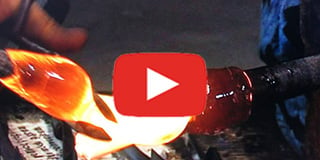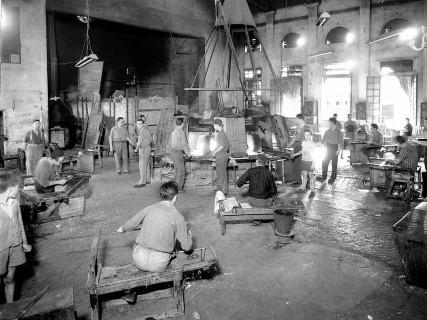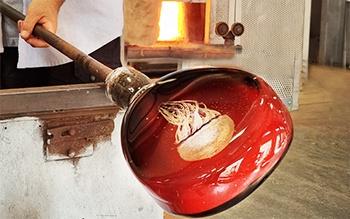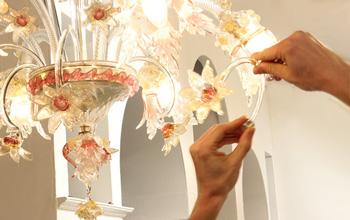This is a documentary video produced by Consorzio Promovetro in order to share the knowledge about Murano Island and the Glass making history and Industry.
Murano Glass working description from the old tradition
For centuries murano has conserved the art of glass with jealous closeness, to the point that in the ancient Serenissima Republic of Venice, nobody was allowed to leave the island of murano without official permission.
Although its tradition has been handed down from generation to generation for centuries, from Master to “garzonetto”, father to son, the history of venetian glass working has evolved in a manner that contunies to respect the true traditions, and integral customs of the land, and its history. This has carried to the present day the true largeness and beauty of the works of glass created on the island of Murano.
It is therefore impossible to describe just how and why this art is fascinating, its presentation would demand attention, and knowledge. We will try to give a short description of some of the more important points for those who are interested in knowing more of this wonderful and unique art. It is for this reason that we will start our description of Murano glass with a poem from the book “Il Fuoco” by the famous poet Gabriele D'Annunzio:
“The work proceededs feverishly around the furnace. At the top of the irons for blowning the fused glass swelled, snaking, became silver like a little cloud, shone like the moon, burst, was divided in the thousand thinnest, crackling, rutilanti fragments, more meager of the threads that are looked at morning time in the forests between branch and branch. The craftsmen modeled the harmonious goblets, everyone obeying in operating to a rhythm its just generated from the quality of the matter and the custom of the moviments apt to dominate it. The "garzoni", they placed one small burning paste pear in the points indicates from the masters and the pear grew tall, was twisted, changed in a handle, a lip, a spout, a stem, one base. The flush under the devises was dispersed little little; and the rising goblet was exposed again to the flame, drived in canes; then it was malleable, ductile, sensitive feature to most tenuous touches that they adorned it, that refined it, than they rendered it in compliance with the model transmitted from ancestors or to the free invention of the new creator. The human gestures were extraordinarily agile and light around those elegant creatures of the fire, the blown and the iron, like the gestures of a silent dance .”
The creation of glass begins with mineral sands fused to high temperature in refractory urns within the furnaces. In the first phase the sands come already mixed to ceate different types of glass, such as crystal or different colors such as zaffiro, and differing tonalities. Often the recipes for such glass come from estates with furnaces that can only hold the one type of glass [I do not know if this last sentence is an accurate grammatical translation of what was meant in the original italian].
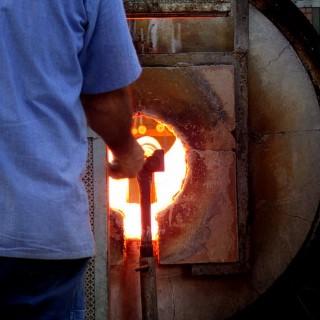
The temperature that it takes to fuse, and create this glass varies from 1200 to 1400 celcius. As it reaches this temperature the hot minerals mix to form a liquid glass. This is the phase where the glass is stirred to obtain the intentional color to fuse. The working phase of the glass requires a lowering of the furnace temperatures to 800 degrees celcius to increase the consistency of the glass. It is at this phase that several tests are blown to measure the elasticity of the glass.
The liquid glass is gathered on the end of the blowpipe by one of the assistants of the Master, called the “servente” or “garzonetto” This procedure, called “evare” consists of the servente rolling the pipe in the furnace, and then lifting it out of the glass, and spinning the pipe to remove any excess.
On top of the bubble, several materials may be added, such as precious metal leaf, murrine, thin canes of glass, pastes for color, or aventurine. These are fused to the bubble for decorative effect.
On most occassions the glass is reheated many times during the working process, however there is a famous saying “fatto alla prima” (made at first). This means that the final object only needs one heating cycle. This is carried out by the master whose experience and training gives him the ability to work efficiently enough to create the piece in one heat.
The master sits on his “scagno” or working bench, and creates the shapes he desires by coordinating with the servente, who prepares the glass as needed and also adds the glass to the piece where the master instructs. In this way the master gives the piece shape and substance with skill and art.
Many of the objects that are created demand that the master bring them back to temperature numerous times. Between these reheats the glass is worked with tools and pliers of various types.
The glass is pulled, crushed, pinched, ironed, striped, lengthened and cut. As jugglers, the masters turn the glass atop the pipes forming symmetrical circles in the air. All these movements give the glass its desired shapes. Pipes with small holes at the end are used to create pressure inside the glass. The air blwon creates bubbles which will make the shape of the glass rounded for goblets, vases, and many other forms.
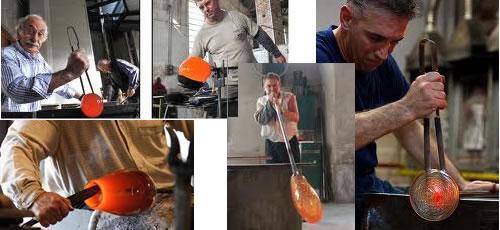
While the assistant blows and turns the glass in order to maintain its centerness perfectly, the master works it, giving it its shape with blocks of wood bathed in water. Another phase is called “pontello” and is used to build the object without ruining the base. The assistant adds the a pontil rod to the bottom of the piece of glass with a small bit of glass. In this way it is the top half that is exposed for manipulation from other positions.
Many times tools made of wood are used for blowing glass. These are made from pear tree wood, and used as stamps. They are made by wood craftsmen by hand. Metal tools, such as scissors, pliers etc, are created and worked by skilled metalworkers, who discuss and design the shapes at the request of the glass masters.
After the piece is finished, it is annealed in an appropriate furnace. This is called “tempera” and as the name implies, it gradually brings down the temperature, and safely removes the possibility of exploding glass. The glass is, as soon as possible, put on a bed of sand, so that it cannot collapse in on itself.
After the glass has safely cooled to room temperature, another phase of the process begins: The delicate cold work of the glass, called “Moleria”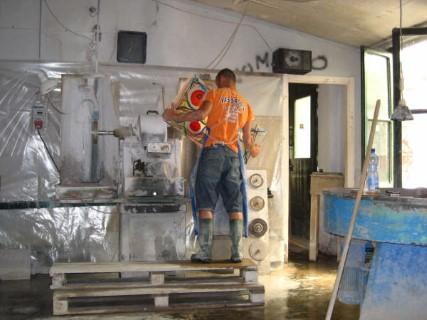 . see the photo on the right.
. see the photo on the right.
The grinding of the piece is one of the techniques used to create particular effects in the surfaces of the object. In this phase the imperfections are smoothed, and it is embellished with various marks that give different effects of light and colors. In this way imperfections are smoothed, and pieces are embellished with cuts of various shapes, and sizes. In the last few decades the importance of cold work has been realized, and used to great effect, by many Masters. The machinery used moves stone wheels of various shapes, and sizes. These all have one thing in common, and that is the use of a water bath, which allows the master to further work the piece by hand.
To conclude, an excerpt from a letter from the 1880s
From a old letter in years 1880.
“There is not a doubt that the mother of all these Arts is that one de' Fornasieri di Murano, while from this born "Quari", than they are reduced in Spechi( mirrors), Lastre and Supiadi (blowed), and not the cane pierced for the Art of the Perleri (masters who made beads), and full cane to use the "Margariter", all these Art have their provision from the Furnaces of Murano, without of that the same arts cannot use their works”.



